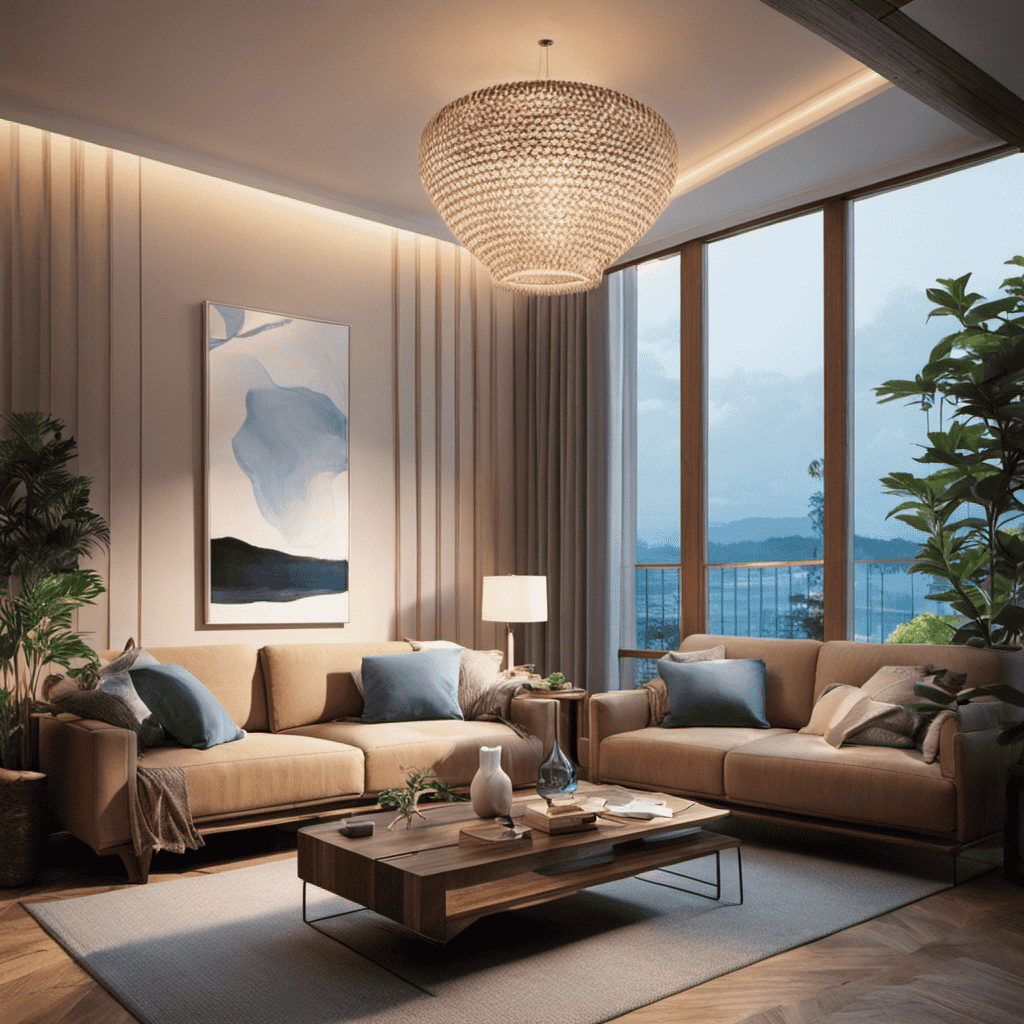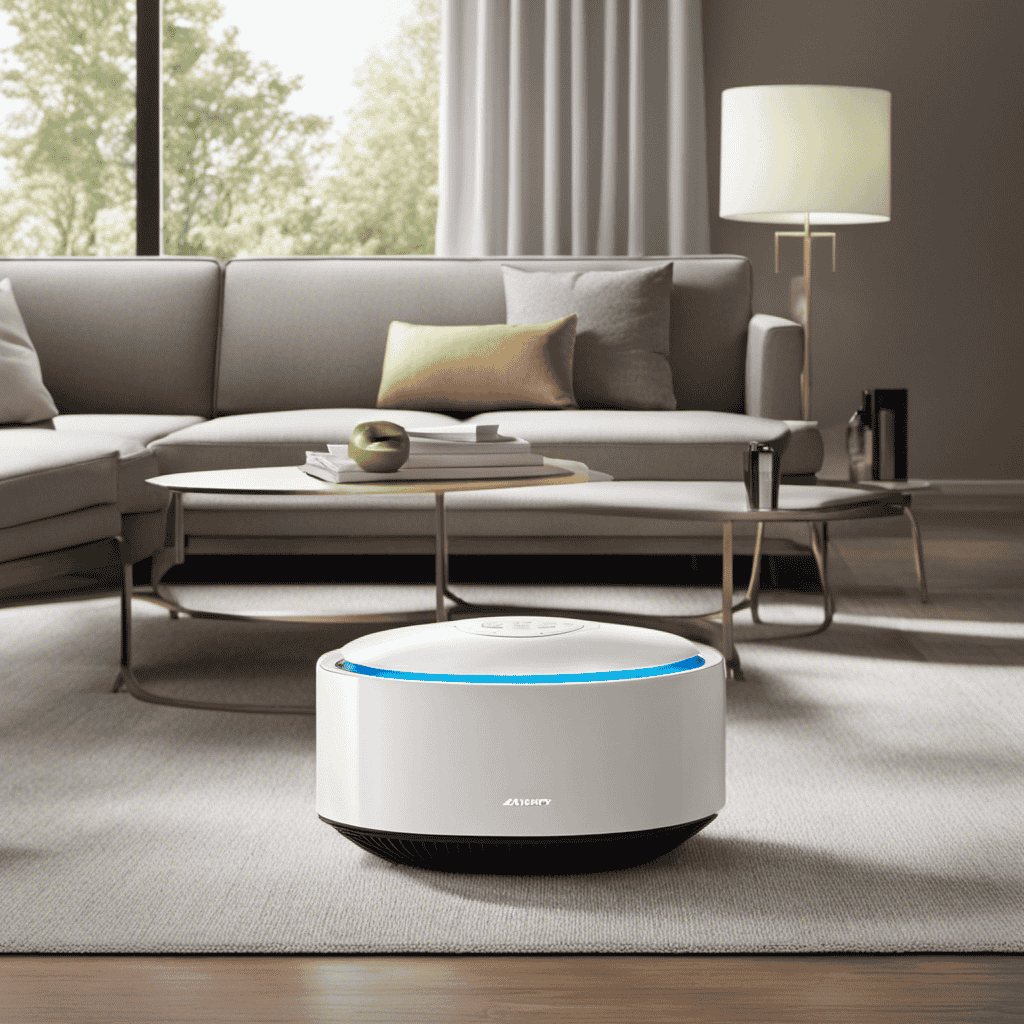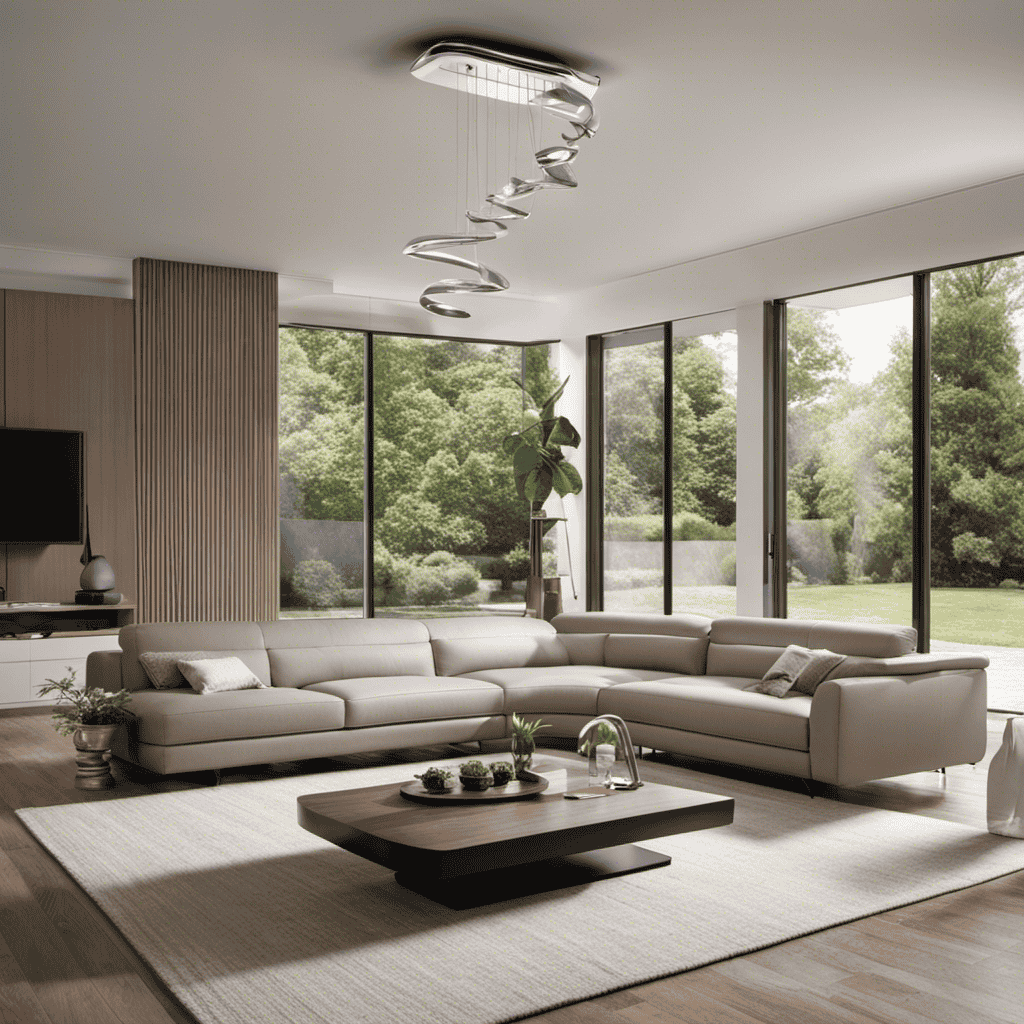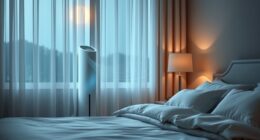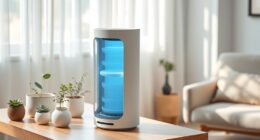I have always been curious about the ideal length of time to run my air purifier to maintain clean and healthy air in my home. It feels like having a protector against pollutants and allergens, but I have never been certain about the best duration.
In this article, we’ll delve into the importance of air purifiers, factors to consider when using one, and the recommended duration for maximum effectiveness. Let’s uncover the science behind air purification and discover how long we should really keep our purifiers running.
Key Takeaways
- The duration of air purifier operation depends on factors such as room size, indoor air quality, and pollutant levels.
- Regular maintenance, including cleaning or replacing filters, is crucial for the optimal functioning of an air purifier.
- Choosing the right size air purifier is important to ensure effective air cleaning without unnecessary energy consumption.
- Air purifiers provide numerous health benefits, including reducing the risk of respiratory problems, improving sleep quality and productivity, and removing allergens and odors.
The Importance of Air Purifiers
Air purifiers are essential for your health and can help remove pollutants from the air you breathe. Maintaining your air purifier is crucial to ensure it continues to function optimally and provide clean air. Regular maintenance includes cleaning or replacing the filters, checking the fan and motor, and keeping the unit free from dust and debris.
When it comes to choosing the best air purifier for your needs, several factors should be considered. Firstly, the size of the room or area where you plan to use the purifier is important. Different models have different coverage areas, so it’s essential to choose one that can effectively clean the air in your space.
Secondly, consider the type of pollutants you want to target. Some air purifiers are specifically designed to remove allergens like pollen, pet dander, and dust mites, while others are more effective at eliminating odors, smoke, or volatile organic compounds (VOCs).
Lastly, look for air purifiers with high CADR (Clean Air Delivery Rate) ratings. This indicates the purifier’s ability to remove specific pollutants from the air. The higher the CADR, the more efficiently the purifier can clean the air.
Factors to Consider When Using an Air Purifier
One important factor to consider when using an air purifier is the duration of its operation. The length of time you run your air purifier can greatly impact its effectiveness in improving indoor air quality. Here are some factors to consider and tips for usage:
| Factors to Consider | Tips for Usage |
|---|---|
| Room size | For smaller rooms, running the air purifier for a shorter period may be sufficient. In larger rooms, it may be necessary to run it for longer to achieve desired results. |
| Indoor air quality | If the indoor air quality is poor or if you have specific concerns such as allergies or asthma, it is recommended to run the air purifier for longer periods. |
| Pollutant levels | If there are higher pollutant levels in the environment, such as during a wildfire or if you live in a heavily polluted area, running the air purifier for longer can help reduce the concentration of pollutants. |
| Noise level | Consider the noise level of the air purifier. If it is too loud, running it for shorter periods during the day and longer periods at night can be a good solution. |
Taking these factors into account, it is important to find the right balance between air purification and energy consumption. In the next section, we will discuss the recommended duration for using an air purifier and provide further guidance on optimizing its operation.
Recommended Duration for Using an Air Purifier
When it comes to optimal purifier usage, there are several key points to consider.
Firstly, it is important to understand the recommended duration for using an air purifier in order to maximize its effectiveness.
Additionally, it is crucial to be aware of the health benefits that a purifier can provide, such as removing harmful pollutants and allergens from the air we breathe.
Optimal Purifier Usage
To get the most out of your air purifier, it’s recommended that you keep it running consistently throughout the day. This will maximize its efficiency and ensure that the air in your home is constantly being purified.
Here are some tips for optimal purifier usage:
-
Set a schedule: Program your air purifier to run during the times when you are most likely to be at home, such as in the morning and evening.
-
Keep it on at night: While you sleep, your air purifier can continue to clean the air, ensuring you wake up to a fresh environment.
-
Use it in high traffic areas: Place your air purifier in the rooms where you spend the most time, such as the living room or bedroom.
-
Consider the size of the room: If you have a larger room, you may need to run your air purifier for longer periods of time to effectively clean the air.
-
Replace filters regularly: To maintain optimal performance, make sure to replace the filters according to the manufacturer’s recommendations.
Health Benefits of Purifier?
Ensure that you take advantage of the health benefits of your purifier by running it consistently and following the recommended usage tips.
Clean air is essential for our well-being, and a purifier plays a crucial role in maintaining the air quality in our homes. By removing pollutants, such as dust, pollen, and pet dander, a purifier helps to reduce the risk of respiratory problems and allergies.
Breathing in clean air can also improve sleep quality, boost productivity, and enhance overall health.
To maximize the benefits of clean air, regular maintenance of your purifier is necessary. This includes cleaning or replacing filters as recommended, checking the airflow, and keeping the unit free from dust and debris.
The Impact of Air Quality on Health
The impact of air quality on health can be significant, so it’s important to consider the benefits of using an air purifier.
Air pollution, caused by various factors such as vehicle emissions, industrial activities, and indoor pollutants, can have detrimental effects on our respiratory system. Breathing in polluted air can lead to respiratory diseases such as asthma, bronchitis, and even lung cancer.
To improve air quality and protect our health, using an air purifier can be beneficial. Here are some key advantages:
- Enhanced productivity: Clean air helps us stay focused and alert, improving our cognitive abilities and productivity.
- Reduced allergies: Air purifiers can remove allergens like pollen, dust mites, and pet dander, providing relief to those with allergies.
- Elimination of odors: Air purifiers help eliminate unpleasant odors from cooking, smoking, or pets, making our living spaces more pleasant.
- Asthma management: People with asthma can benefit from air purifiers as they remove triggers like dust and smoke that can worsen symptoms.
- Filter out harmful particles: Air purifiers with HEPA filters can effectively trap fine particles like PM2.5, which are linked to cardiovascular and respiratory issues.
With the increasing prevalence of air pollution and its detrimental effects on our health, investing in an air purifier can provide a significant improvement in indoor air quality and overall well-being.
Different Types of Air Purifiers and Their Effectiveness
When considering different types of air purifiers, it’s important to understand their effectiveness in improving indoor air quality. Air purifiers work by removing pollutants and allergens from the air, such as dust, pollen, pet dander, and mold spores. They can be particularly beneficial for individuals with allergies or respiratory conditions. However, not all air purifiers are created equal, and their effectiveness can vary depending on factors such as the type of filter used and the size of the unit.
When it comes to air purifier maintenance, it’s crucial to regularly clean or replace the filters. This ensures that the purifier continues to function optimally and effectively removes pollutants from the air. Additionally, choosing the right size air purifier for your space is essential. A unit that is too small may not effectively clean the air, while one that is too large may consume unnecessary energy.
In the next section, we will explore the signs that indicate it’s time to turn on the air purifier. By understanding these indicators, you can ensure that your air purifier is operating when it’s most needed to improve indoor air quality and promote a healthier living environment.
Signs That Indicate It’s Time to Turn on the Air Purifier
Now that we understand the different types of air purifiers and their effectiveness, let’s explore when it is appropriate to turn on an air purifier and the benefits of using one.
When to turn on an air purifier:
- When you notice a buildup of dust or pet dander in your home.
- During peak allergy seasons when pollen and other allergens are abundant.
- After cooking or using cleaning products that release fumes or odors.
- When someone in the household is sick to help reduce the spread of germs.
- In areas with poor air quality due to pollution or nearby construction.
Benefits of using an air purifier:
- Removes airborne particles such as dust, pollen, pet dander, and mold spores, improving indoor air quality.
- Reduces exposure to indoor air pollutants, which can lead to respiratory issues and allergies.
- Helps control odors by capturing and neutralizing particles that cause unpleasant smells.
- Filters out pet hair and dander, making it easier to maintain a clean and allergen-free home.
- Creates a healthier environment, especially for individuals with asthma or other respiratory conditions.
How Long to Run an Air Purifier in Different Environments
It’s important to consider the recommended duration for running an air purifier in various environments. When it comes to bedrooms, it is generally advised to run the air purifier continuously throughout the night. This ensures that you have clean air to breathe while you sleep, as bedrooms tend to accumulate dust, allergens, and other pollutants. By running the air purifier overnight, you can wake up feeling refreshed and breathing easier.
In offices, the duration for running an air purifier can vary depending on the size of the space and the number of people present. For smaller offices with a few individuals, running the air purifier for a few hours during the workday can help maintain clean air quality. However, in larger offices with more people and higher levels of pollutants, it may be necessary to run the air purifier continuously throughout the day to ensure optimal air quality.
There are several benefits to running an air purifier in offices. Firstly, it helps remove airborne particles such as dust, pollen, and pet dander, which can lead to allergies and respiratory issues. Additionally, air purifiers can help eliminate odors from food, cleaning products, and other sources, creating a more pleasant and comfortable work environment.
Tips for Maximizing the Benefits of Your Air Purifier
To get the most out of your air purifier, make sure to regularly clean or replace the filters. This is important because clean filters ensure that your air purifier is functioning at its maximum efficiency. Here are some maintenance tips to help you maximize the benefits of your air purifier:
-
Vacuum the exterior: Dust and debris can accumulate on the exterior of your air purifier, which can hinder its performance. Regularly vacuuming the exterior will help keep it clean and free from obstructions.
-
Clean the pre-filter: Many air purifiers have a pre-filter that captures larger particles. Cleaning or replacing this filter regularly will prevent it from becoming clogged and allow it to effectively capture larger particles, extending the life of the main filter.
-
Check the indicator lights: Most air purifiers have indicator lights that let you know when it’s time to clean or replace the filters. Pay attention to these lights and follow the manufacturer’s recommendations to ensure optimal performance.
-
Keep the air purifier in the right location: Placing your air purifier in an area with good airflow and away from obstructions will help it operate more efficiently. Avoid placing it near walls or furniture that could block airflow.
-
Regularly clean the room: Dust and allergens can accumulate on surfaces in your room, making it harder for the air purifier to effectively clean the air. Regularly clean the room to reduce the amount of particles in the air and help your air purifier work more efficiently.
The Role of Air Purifiers in Reducing Allergies and Asthma Symptoms
If you suffer from allergies or asthma, using an air purifier can help reduce your symptoms by filtering out allergens and irritants from the air.
Air purifiers are particularly effective in reducing symptoms caused by pet allergies and smoke. Pet dander, saliva, and urine can trigger allergic reactions in sensitive individuals. Air purifiers for pet allergies are designed to capture and eliminate these allergens from the air, providing relief to allergy sufferers.
Similarly, air purifiers for smoke are equipped with specialized filters that can effectively remove smoke particles and odors from the air. This is especially beneficial for individuals who are exposed to secondhand smoke or live in areas with high levels of air pollution.
By continuously running the air purifier, you can ensure that the air in your home remains clean and free from allergens and irritants. It is recommended to keep the air purifier on at all times, as allergens and irritants can quickly accumulate in the environment.
However, it is important to regularly clean and maintain the filters to ensure optimal performance. Overall, air purifiers are an essential tool in managing allergies and asthma, providing a clean and healthy indoor environment.
Common Misconceptions About Using Air Purifiers
One common misconception about using air purifiers is that they are only effective for reducing pet allergies and smoke particles. While it is true that air purifiers are great at filtering out pet dander and smoke particles, their benefits extend far beyond that. Here are some common misconceptions about air purifiers that need to be debunked:
-
Air purifiers only remove visible particles: Contrary to popular belief, air purifiers are designed to capture not only visible particles but also microscopic pollutants, such as mold spores, pollen, and dust mites.
-
Air purifiers eliminate all odors: While air purifiers can help reduce certain odors, they cannot completely eliminate all smells. Strong odors, such as those from cooking or chemicals, may require additional measures.
-
Air purifiers are noisy: Modern air purifiers are designed to operate quietly, so you can enjoy clean air without any disturbance. Look for models with noise-reducing features if noise is a concern.
-
Air purifiers are expensive to run: Air purifiers are actually energy-efficient appliances that consume minimal electricity. Additionally, the long-term health benefits they provide outweigh the costs.
-
Air purifiers are only useful for those with allergies: While air purifiers are particularly beneficial for individuals with allergies or asthma, they can improve indoor air quality for everyone, promoting overall well-being.
It is important to debunk these myths and understand the true capabilities of air purifiers. By doing so, we can make informed decisions about our indoor air quality and improve the health and comfort of our living spaces.
Frequently Asked Questions
Can Air Purifiers Remove All Types of Pollutants From the Air?
Air purifiers have limitations when it comes to removing all types of pollutants from the air. While they’re effective at capturing and removing airborne particles like dust, pollen, and pet dander, they may not be able to eliminate gases, chemicals, or odors.
These types of pollutants can require additional filtration methods or specialized air purifiers. It’s important to consider the specific needs of your indoor environment and choose an air purifier that is designed to target the pollutants you want to remove.
Are Air Purifiers Effective in Reducing Odors?
Air purifiers are effective in reducing odors, particularly pet odors. When comparing air purifiers for odor reduction, it is important to consider their filtration system and the presence of activated carbon filters.
These filters are designed to absorb and eliminate odors from the air, leaving it fresh and clean. The effectiveness of air purifiers in removing odors may vary depending on the size of the room and the intensity of the odor.
Can Air Purifiers Help With Respiratory Conditions Other Than Allergies and Asthma?
Air purifiers can be helpful in managing respiratory conditions beyond allergies and asthma. They are also effective in reducing the risk of respiratory infections, including COVID-19. By filtering out airborne particles and contaminants, air purifiers can create a cleaner and healthier indoor environment.
However, the duration for which you should keep the air purifier on may vary depending on the specific needs and circumstances. It is recommended to follow the manufacturer’s instructions and consult with a healthcare professional for personalized guidance.
Do Air Purifiers Consume a Lot of Electricity?
Air purifiers vary in energy consumption, but they generally don’t consume a lot of electricity. It’s important to consider the specific model and its energy efficiency rating.
Some purifiers have smart features that allow them to adjust their speed based on air quality, minimizing energy usage. When choosing an air purifier, it’s worth considering its long-term cost effectiveness, including energy consumption and filter replacement costs.
Overall, air purifiers can be a valuable addition to improve indoor air quality without significantly increasing electricity bills.
Are There Any Health Risks Associated With Using Air Purifiers for Extended Periods of Time?
Using an air purifier for extended periods of time can have both health benefits and potential risks.
On one hand, air purifiers can effectively remove pollutants and allergens from the air, improving indoor air quality and reducing respiratory issues.
However, it is important to consider maintenance tips to avoid any negative effects. Regularly cleaning and replacing filters, as well as ensuring proper ventilation, can help prevent the buildup of harmful substances and maintain the effectiveness of the air purifier.
Conclusion
In conclusion, keeping an air purifier running consistently is like having a vigilant guardian for your indoor air quality. It tirelessly captures and eliminates harmful pollutants, ensuring you breathe in nothing but pure, fresh air.
Just like a loyal companion, it stays by your side, protecting you from allergies and asthma triggers.
So, don’t underestimate the power of your air purifier. Let it be your shield, guarding your health and creating a haven of clean air in your home.
